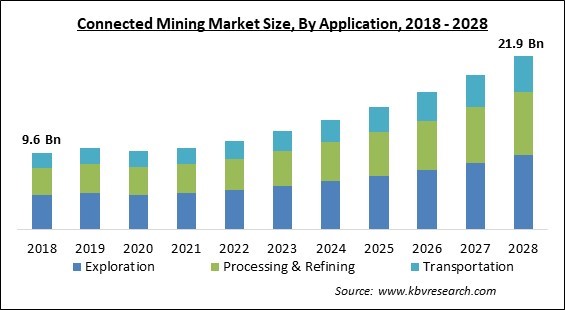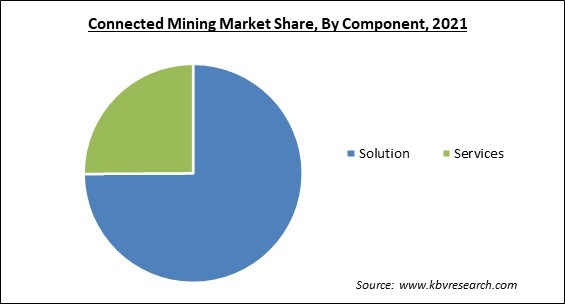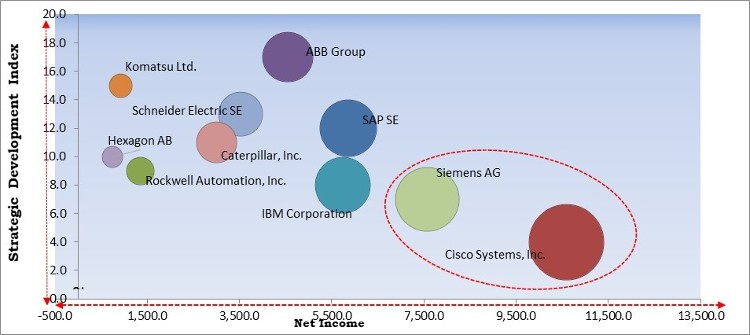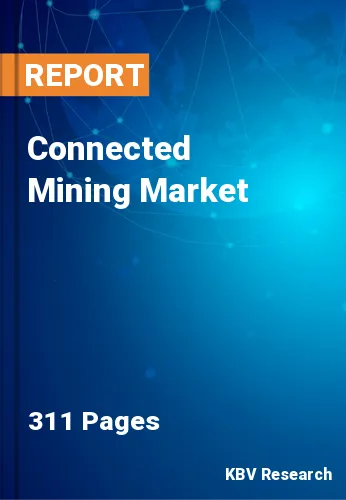The Global Connected Mining Market size is expected to reach $21.9 billion by 2028, rising at a market growth of 11.8% CAGR during the forecast period.
Connected mining is the next-generation land mine system that combine surface and underground mining for increased efficiency in the extraction and administration of mining resources. It creates a highly secure information protocol (IP) and multi-service networks in mines to track wall slope stability, surface movement, fracture and fault detection, and natural seismicity. It encompasses a wide range of technologies and solutions, including logistics, smart assets, operational data processing and analytics, control systems, safety and security systems, and remote management solutions. They are installed on mining machines and provide a variety of benefits, including increased production efficiency and worker safety, as well as reduced production costs and real-time asset visibility.
The use of information and data, autonomy, and technology to promote high production, improved safety, and lower operational costs during the mining process is referred to as smart mining. System integration, consulting services, and engineering and maintenance are the three types of services. These solutions are typically provided as single-point solutions that are tailored to a company's specific needs and readily integrated with its existing business platform.
Furthermore, the growing demand for improved safety and security measures for mine workers is propelling the industry forward. By monitoring and communicating with integrated systems in real-time, connected mining allows businesses to boost their production capacities. It also enables predictive maintenance, which includes on-site cost monitoring and resource usage via digital tail monitoring controls.
Another growth-inducing aspect is the integration of the Industrial Internet of Things (IIoT), big data, and cloud computing technologies with mining equipment. Service providers are also developing more adaptable platforms, sensors, processors, and software in order to provide a better customer experience, which is propelling the market forward.

COVID-19 has had a significant influence on the mining industry, with a number of mine operators being forced to temporarily close their mines owing to government-imposed shutdowns or functioning with a lower workforce. The mining industry's productivity has been harmed as a result of this predicament. Mining businesses were confronted with issues such as a lack of skilled labor and price volatility. After a year of trying to recover from the pandemic, the mining sector focused on developing solid operations, supply chains, reducing carbon emissions, and working with the support of digital technology. The mining sector has reacted rapidly and collectively to develop innovative measures to mitigate COVID-19's impact on mining operations while also protecting the health of the workers.
One of the most precious commodities for businesses is data. Drills, trucks, shovels, conveyors, trains, and ships produce massive volumes of important data every day. Various suppliers are making their organizations safer and more productive by merging this information with machine learning, artificial intelligence, smart analytics, and automation. Digital transformation projects in the mining sector, according to the World Economic Forum, will produce more than USD 190 billion in industry value over the next decade. InterSystems IRIS for Mining Operations is next-generation digitalization software for mining companies that integrates with existing machinery and software.
The implementation of Mining 4.0 to revolutionize the mining process has accelerated in recent years. Various technological developments have been made in the last few decades to address the challenges faced by the mining industries since the 17th century, such as mine worker safety, equipment sustainability, and onsite and underground decision-making, and today mining companies are heavily investing in implementing Mining 4.0 solutions. Mining 4.0, which uses big data, IoT, 5G, cloud, and AI technologies to connect operations in the mining industry, is enabled by Industry 4.0.
The mining industry's biggest problem is a scarcity of qualified personnel. Silver Lake Resources modified its strategy in June 2021, according to Australian Mining, due to a lack of skilled labor at the Mount Monger gold mine. This problem has led to lowered production and raised overall costs. Especially during the pandemic, mining businesses struggled and fought for experienced professionals. Experts are needed by mine operators to supervise the transfer of massive amounts of essential data from remote locations. In this industry, companies are focusing on hiring the greatest personnel to idealize, develop, and find innovative concrete solutions to problems.

Based on Component, the market is segmented into Solution and Services. Based on Solution Type, the market is segmented into Asset Tracking & Optimization, Industrial Safety & Security, Fleet Management, Workforce Management, Analytics & Reporting, and Others. The services segment observed a substantial revenue share in the connected mining market in 2021. Support and maintenance services, consulting services, and system integration services are examples of professional services. Consulting services are generally focused on managing business operation revolution programs and the most recent technological updates in order to assist clients in achieving strategic company objectives through technological and business improvements. Integration is the process of linking many subsystems or components into a bigger system so that it can function as a single IoT system. Integration and deployment services combine various technological products and applications, including legacy platforms, to reduce IT-related difficulties and increase a company's return on investment.
Based on Application, the market is segmented into Exploration, Processing & Refining, and Transportation. The transportation segment obtained a promising revenue share in the connected mining market in 2021. Some mining businesses are already utilizing self-driving trucks and trains that can be tracked and operated remotely. Aside from enabling efficient material transport and allowing personnel to focus on other activities, autonomous transportation has the potential to improve safety. Transportation accidents are a big threat to the safety of the mineworkers. Autonomous transportation can solve this issue.
Based on Deployment Mode, the market is segmented into On-premise and Cloud. The cloud segment witnessed a significant revenue share in the connected mining market in 2021. Industries are gradually migrating their storage from on-premise to the cloud, owing to the increased efficiency of work processes and storage capacity provided by cloud services. An organization's capital and operational costs can be reduced by using the cloud. With no in-house server storage and application requirements, it helps to save significant capital expenses.
Based on Mining Type, the market is segmented into Surface and Underground. The surface mining segment acquired the largest revenue share of the connected mining market in 2021. Surface mining is a type of mining that extracts minerals and ores that are found near the Earth's surface. In addition, Surface mining is the deliberate removal of exterior layers of rock from the earth to obtain ore reserves. Such kind of mining is used in the majority of mining projects because it is relatively more cost-efficient, simple to manage, and less dangerous. Mountaintop Removal (MTR), open-pit mining, strip mining, dredging, and highwall mining are all examples of surface mining. The most frequent type of mining technology is open-pit mining, which is used to extract near-surface ores. Ore resources are mined from water sources such as rivers, lakes, and the ocean.
| Report Attribute | Details |
|---|---|
| Market size value in 2021 | USD 10.3 Billion |
| Market size forecast in 2028 | USD 21.9 Billion |
| Base Year | 2021 |
| Historical Period | 2018 to 2020 |
| Forecast Period | 2022 to 2028 |
| Revenue Growth Rate | CAGR of 11.8% from 2022 to 2028 |
| Number of Pages | 311 |
| Number of Tables | 523 |
| Report coverage | Market Trends, Revenue Estimation and Forecast, Segmentation Analysis, Regional and Country Breakdown, Competitive Landscape, Companies Strategic Developments, Company Profiling |
| Segments covered | Component, Deployment Mode, Application, Mining Type, Region |
| Country scope | US, Canada, Mexico, Germany, UK, France, Russia, Spain, Italy, China, Japan, India, South Korea, Australia, Malaysia, Brazil, Argentina, UAE, Saudi Arabia, South Africa, Nigeria |
| Growth Drivers |
|
| Restraints |
|
Based on Regions, the market is segmented into North America, Europe, Asia Pacific, and Latin America, Middle East & Africa. The APAC region acquired the maximum revenue share in the connected mining market in 2021. China, Indonesia, India, the Philippines, and Papua New Guinea (PNG) are likely to lead the industry in the Asia Pacific region, with China being the most promising player in smart mining efforts. Because of the country's growing demand for minerals, India can be deemed the next high-potential preference for the leading global-linked mining industry suppliers. Investment projects are driving the region's development in industrial capacity. The adoption of technology like remote monitoring, operational analytics and data processing, and mining safety systems is high in this region.
Free Valuable Insights: Global Connected Mining Market size to reach USD 21.9 Billion by 2028

The major strategies followed by the market participants are Partnerships. Based on the Analysis presented in the Cardinal matrix; Cisco Systems, Inc. and Siemens AG are the forerunners in the Connected Mining Market. Companies such as IBM Corporation, SAP SE and ABB Group are some of the key innovators in the Market.
The market research report covers the analysis of key stake holders of the market. Key companies profiled in the report include ABB Group, IBM Corporation, SAP SE, Cisco Systems, Inc., Schneider Electric SE, Komatsu Ltd., Hexagon AB, Caterpillar, Inc., Rockwell Automation, Inc., and Siemens AG.
By Component
By Application
By Deployment Mode
By Mining Type
By Geography
The global connected mining market size is expected to reach $21.9 billion by 2028.
Rising Demand for Data Management & Analytics are increasing are driving the market in coming years, however, scarcity of skilled labor growth of the market.
ABB Group, IBM Corporation, SAP SE, Cisco Systems, Inc., Schneider Electric SE, Komatsu Ltd., Hexagon AB, Caterpillar, Inc., Rockwell Automation, Inc., and Siemens AG.
Yes, The mining industry's productivity has been harmed as a result of this predicament. Mining businesses were confronted with issues such as a lack of skilled labor and price volatility.
The Solution market dominated the Global Connected Mining Market by Component in 2021; thereby, achieving a market value of $15.5 billion by 2028.
The Asia Pacific is the fastest growing region dominated the Global Connected Mining Market by Region in 2021; thereby, achieving a market value of $7.9 billion by 2028.
Our team of dedicated experts can provide you with attractive expansion opportunities for your business.

